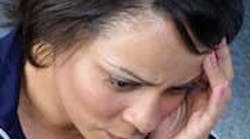“Oh, my aching head!” For those who suffer from the occasional headache to those who have persistent migraines, truer unfortunate words have never been spoken. As a migraine sufferer, I know that headaches may be debilitating. One in 10 Americans suffer from headaches. And not all headaches are created equal. They vary in intensity, duration, and location.
The experience may range from throbbing, stabbing pain to a dull ache, with all varieties in between. Headaches may last from a few minutes to days. Some patients feel tightness around their entire head and some may exhibit pain unilaterally or focused in one location, such as behind one eye. The temple or the occipital lobe areas are common centers of pain locus.
Headaches are categorized into two basic types: primary and secondary. Primary headaches have their own etiologies. Secondary headaches are caused by other medical issues. Patients with regular, primary headaches are further classified into three types: tension, migraine, and cluster. Some headaches are not so easily categorized. They may have components of different types.
Tension headaches are usually caused from stress, and are the most common type of headaches. Muscular tension is a huge trigger, especially in the neck region. The pain may be mild and tends to spread in a band across both sides of the head, with duration of minutes to hours. They may occur frequently, depending on the precipitating factors. Triggers may be noise or stuffy environments, but stress is the main culprit. Typically, tension headaches occur in women over the age of 20.
Common migraines are intense throbbing, severe headaches, located on one side of the head. The “calling card” of this headache is its unilateral, pounding nature. Classic migraines also have the severe, throbbing, unilateral pain, in addition to sensitivity to light, sound, and smell. Nausea may occur, with or without vomiting. Migraines are likely related to the dilation of blood vessels in the brain. Between 20 to 30 percent of all migraine sufferers experience an aura, which manifests as a disturbance of visual symptoms, such as blinking or moving lights. Auras usually last between five and 20 minutes. Some patients also exhibit prodromal symptoms of fatigue, hunger, or nervousness. Both auras and prodromal symptoms will alert the patient that a migraine is imminent. Migraines usually last between four to 12 hours. When a migraine strikes, patients try to find a dark, quiet room, with no activity. Click here to view Headache Medication Table
Twenty-five million Americans suffer from migraines. Seventeen percent of women and 5 percent of men have had one or more migraines a year. Migraines may develop between the ages of 10 to 30, with waning incidence after the age of 50 or 60. Patients as young as three years of age also may experience these headaches. Changes in the weather, strong, glaring or flashing light, or intense odors, such as smoke or perfume, may be environmental triggers for migraines. Certain food items, such as red wine, chocolate, nitrites, alcohol, aged cheeses, monosodium glutamate, caffeinated beverages, nuts, and citrus foods may also induce a migraine. Skipping meals may also bring on this headache. Hormonal fluctuations due to menses, ovulation, or oral contraceptives, and stress have also caused the headaches. Genetics also may play a role.
Cluster headaches are not as common as the first two types (1 percent of the population). Eighty-five percent of all cluster headache sufferers are male. As the name suggests, the headaches occur in “clusters” or groups, lasting for days, weeks, or months. The time is usually the same each day, and the pain is excruciating, usually centered around one eye. Nasal congestion and eye inflammation on the affected side may occur. Cluster headaches are brief, with a usual duration between five minutes to two hours, although they may reoccur several times during one day. As opposed to migraines, patients often feel better if they move around.
Headaches come about infrequently or chronically. Chronic headaches may occur daily and will exhibit symptoms of both tension and migraine headaches. Triggers may include depression and stress. Overuse of pain relief medication may also cause chronic or rebound headaches. When the medication wears off, a rebound headache may occur. Rebound headaches may occur with caffeine-containing medications. Chronic headaches may cause issues of their own, such as sleep deprivation.
Secondary headaches may have a more serious medical etiology, which may be either benign or more serious. As previously mentioned, hormonal fluctuation may cause some migraines in the female population (occurring around the time of menses).
Remember the last time you forgot to drink that morning cup of coffee? Withdrawal from caffeine or nicotine can give you a headache. Dehydration and poor nutrition may trigger headaches in some patients. Medical conditions, such as brain tumors, strokes, aneurysms, head trauma, and meningitis may also elicit headaches. Sinus or dental infections may also give a patient a headache. Some antihypertensive and antidepression medications may also have headaches as a side effect.
Headaches may be manageable with no medication. The occasional sufferer may not require any intervention, aside from an alteration in diet or more exercise. A variety of medications are used to stop or calm headaches (see Table 1). They range from simple over-the-counter analgesics, such as aspirin or nonsteroidal anti-inflammatory drugs, to abortive prescription drugs. Pain relievers tend to control headaches but may not make them disappear. They are effective for mild or infrequent headaches and have few side effects, but may cause rebound headaches if overused. Some OTC drugs are habit-forming.
Preventive medications are taken daily. These drugs are prescribed for patients with more frequent or prolonged headaches. They do not stop a headache that is in progress, but may assist the effects of pain relievers. Abortive drugs will stop a headache, but may not always stop the pain. Timing is key when these medications are utilized. They must be taken when the patient first feels the headache. Both of these drug classifications have side effects, but - especially with the abortive drugs - the side effects may be more tolerable than the pounding headache.
Some patients refuse to use medications or try to work through their headaches without any pharmaceutical assistance. Hypnosis, acupuncture, and biofeedback are alternatives that work for some. Yoga and other exercise programs may offer some relief for tension headaches. When a migraine is full-blown, no form of exercise would be tolerated.
How do we alert patients to get medical assistance? If we have a patient who is suffering from daily headaches or headaches that interfere with work or pleasure, they should seek medical care. Headaches that have escalated over time should be evaluated. Headaches may mask other serious medical issues, such as severe hypertension, stroke, or infection. Upon questioning our patients, we should elicit questions about the quality and quantity of their headaches. Abnormal eye movements, difficulty walking, and weakness in limbs should also be referred for consultation. Appointments may need to be modified or changed to accommodate a headache in full swing.
A healthy lifestyle is always a drug-free treatment for headache control. For some of us, we will not get rid of our headaches until we are well into menopause. Knowing the triggers may be the first step in stopping the pain.
References
National Headache Foundation, http://www.headaches.org
American Council for Headache Education, http://www.achenet.org
American Pain Foundation, http://www.painfoundation.org
Womenshealth.gov, http://www.4woman.gov/faq/migraine.htm







